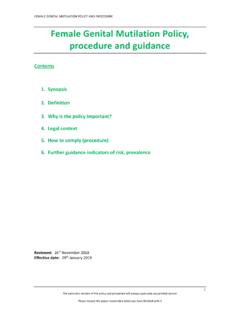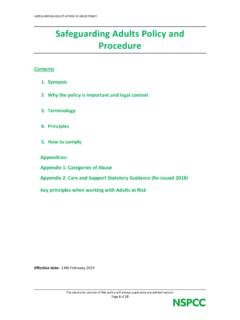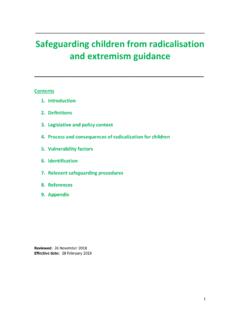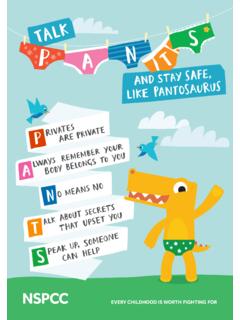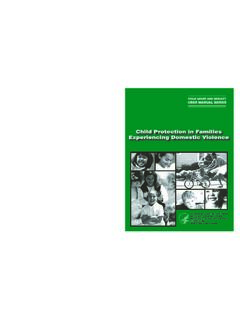Transcription of Safeguarding and Child Protection Policy - NSPCC
1 PUBLIC Page 1 of 7 Safeguarding and Child Protection Policy Contents 1. Overview 2. Our approach to Safeguarding 3. Role and responsibilities Effective Date: 19 February 2019 Approved by: Executive Board February 2019 Safeguarding AND Child Protection Policy The electronic version of this Policy will always supersede any printed version Page 2 of 7 1. Overview Safeguarding1 is at the heart of what we do and fundamental to our existence as a charity. We are all ambassadors for the NSPCC and for Safeguarding . Some of us in the services directorates are specialists in Child Safeguarding practice, others in fundraising have contact with many adults and children, whilst others seldom meet the public as part of their work.
2 But from the point of view of the public we are all the NSPCC , and they expect us to know what to do if they, or we, have concerns about a child2. The purpose of this Policy is to set out the NSPCC s approach to Safeguarding children and adults at risk or vulnerable adults3. It applies to everyone working and volunteering for the NSPCC or acting on their behalf and provides the framework to help us safeguard children with commitment and confidence. It describes some corporate and directorate Safeguarding responsibilities so that you know who to ask for decisions or advice when you need to.
3 2. Our approach to Safeguarding Principles Our approach to Safeguarding is driven by a number of principles which are informed by the UN Convention on the Rights of the Child , relevant legislation and guidance, and by the NSPCC s values and understanding of best practice. Principle 1 All children have a right to Protection from harm and abuse, regardless of age, ability, gender, racial heritage, religious beliefs, sexual orientation, identity or additional vulnerabilities. 1 Definitions: Safeguarding children is the action we taken to promote the welfare (or wellbeing) of children and protect them from harm.
4 Child Protection is part of the Safeguarding continuum and focusses on the activity that is undertaken to protect individual children identified as suffering or likely to suffer significant harm 2 Child : This Policy is in respect of all children. A Child includes babies, children and young people from pre-birth up to 18 years. In Scotland, there is a variance to this where a Child is someone up to the age of 16 years unless the Child is subject to a supervision requirement by a Children s Hearing, in which case they are considered a Child until the age of 18 years. See National Guidance for Child Protection in Scotland 2014 (para 21-24) for more detailed guidance on this 3 An adult at risk is any person who is aged 18 years or over and at risk of abuse or neglect because of their needs for care and support (Care Act 2014 [England]).
5 This definition is broadly consistent with definitions across the devolved nations. In Scotland, the definition of an adult at risk or vulnerable adult applies to those aged 16 years and over. Institute of Fundraising Guidance refers to vulnerable adults . The practical guide to dealing with donations it says that It is important to recognise the distinction between an individual lacking the mental capacity to make a decision and someone who has capacity but may be vulnerable at that moment in time. While both situations require a fundraiser to respond appropriately, the fact that issues around mental capacity have a legal context means that this needs to be understood as a discrete part of this area.
6 Safeguarding AND Child Protection Policy The electronic version of this Policy will always supersede any printed version Page 3 of 7 Principle 2 The best interests of the Child are paramount in all considerations about their welfare and Protection , including when to maintain confidentiality and when to share information about them. Principle 3 Children have a right to participate in decisions about their lives. Their views, wishes, feelings and experiences are evident in our work with them. Principle 4 Concerns or allegations that NSPCC staff or volunteers have abused or neglected a Child or adult will be managed sensitively and fairly in accordance with these policies, relevant legislation and local procedures.
7 Principle 5 Working together with children, their parents, carers and other agencies is essential to promoting children s welfare/wellbeing and ensuring their Protection . In some limited circumstances, it will not be appropriate to engage with parents and carers to protect the Child . Principle 6 As part of working together we expect professionals to act on our concerns, and we will escalate our concerns in our efforts to be satisfied that the Child has been protected, taking a stand in cases where we consider the Protection of the Child has not been taken seriously either within the NSPCC or those investigating Child Protection .
8 What to do for those who do not work directly with children The Child s welfare is paramount and this means that the Child s safety and Protection must be the most important consideration and take priority over everything else. These procedures outline what action should be taken if you have concerns about a Child s4 Safeguarding including Child Protection . The procedures apply to the following individuals: all staff in directorates/teams/services who do not work directly with children or adults at risk, volunteers (including trustees and interns), secondees, agency staff, students, who in the course of their work or volunteering, have information or receive information that gives them cause for concern about a Child s Safeguarding / Child Protection .
9 The procedures also apply to sole traders and contractors, including training associates and fundraising agencies. What to do if for those working directly with children The Child s welfare is paramount and this means that the Child s safety and Protection must be the most important consideration and take priority over everything else. These procedures outline what action should be taken if you have concerns about a Child s5 Safeguarding including Child Protection . The procedures also explain what action should be taken if no satisfactory action has been agreed with the relevant local authority/police or school (as necessary).
10 The procedures apply to the following individuals: all staff and volunteers working directly with children (including trustees and interns), secondees, agency staff, students, who in the course of 4 Child : This procedure is in respect of all children. A Child includes babies, children and young people from pre-birth up to 18 years. In Scotland, there is a variance to this where a Child is someone up to the age of 16 years unless the Child is subject to a supervision requirement by a Children s Hearing, in which case they are considered a Child until the age of 18 years.
